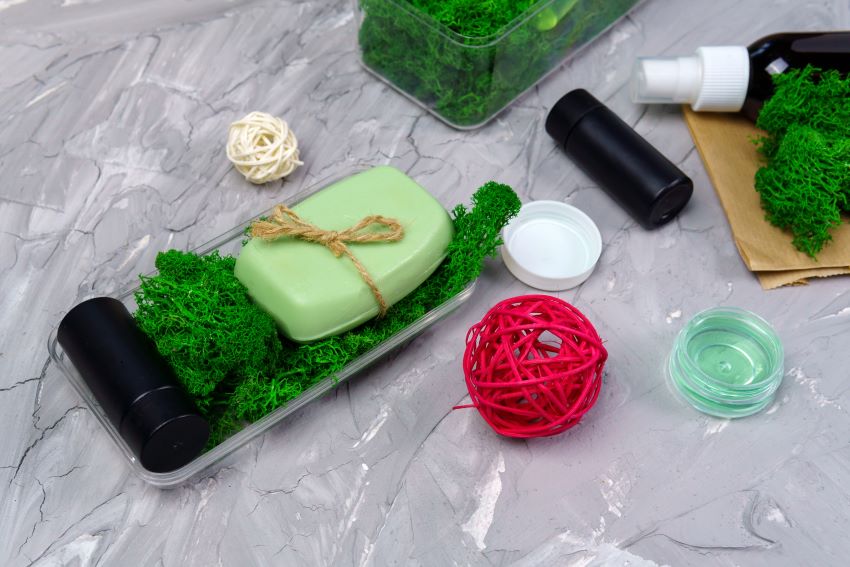
Sea moss is proving to be a valuable asset in the manufacture of skin care products, condiments and food and beverages, among other things, in Barbados.
The Sea Moss Pilot Project commenced in May 2022, and is set to conclude in July, with plans already in train to increase its viability to transform it to a viable industry.
Project Lead on the Sea Moss Pilot Project, Nesaba Browne, said they were aiming to set up a sea moss industry to create value-added products for export.
“So, products that would be in the cosmetic area, the nutraceutical area, food and beverage, that would help us with challenges with food security in Barbados and alleviate stress in terms of nutrients, and take from the ocean in a sustainable manner,” she stated.
Noting that the project was designed to benefit both man and the environment, Ms. Browne explained that it presently involved the cultivation of sea moss on 10 rafters at sea.
She indicated that they were now at the stage of harvesting two rafts every week and had gone through various testing phases to ensure the moss could survive in Barbados’ waters.
“Now, we are about to dry the moss in an ecofriendly, low energy required manner, without using any chemicals. From there, we are handing the moss over to different companies in Barbados, so they can innovate and experiment with the sea moss to create new products,” she explained.
Ms. Browne noted that sea moss could be used in sun block, as it has antioxidant properties that are good for the skin and hair; in food as a source of iodine and minerals; as an alternative to plastic food packaging to replace cling wrap; as an anti-freeze for nondairy ice creams; and as a thickener to replace corn starch.
The Project Lead pointed out that the sea moss is different from the Sargassum seaweed that currently litters the beaches along the island’s south and east coasts.
“This is the red algae, and Sargassum is brown algae. We imported this moss from St. Lucia, and so it naturally grows in Caribbean waters, whereas Sargassum is found in the Sargasso Sea, which is in the Atlantic Ocean,” she said.
“Sea moss could be used in sun block, as it has antioxidant properties that are good for the skin and hair; in food as a source of iodine and minerals; as an alternative to plastic food packaging to replace cling wrap; as an anti-freeze for nondairy ice creams; and as a thickener to replace corn starch.”
Project Lead on the Sea Moss Pilot Project, Nesaba Browne
She added that the Sargassum seaweed acts as an invasive species, while the sea moss occurs naturally, and was around for years. It is used by residents of St. Lucia and St. Vincent.
Ms. Browne further noted that Sargassum is a floating seaweed, while the sea moss is not, and it is being grown on lines, mostly on rocks and edges of coral reefs.
Minister of the Environment and National Beautification, Adrian Forde, explained this all comes under the mariculture and aquaculture industries, which his Ministry is seeking to build out.
“Cabinet made a decision that mariculture and aquaculture must become a new part of the Bajan conversation. We, at the level of Cabinet, agreed to a policy framework for aquaculture and mariculture. We have also said that there must be legislation, which is governed by policy and regulations, which speaks to what is to happen within the industry from registration to end-product, for export and foreign exchange purposes,” he said.
This was supported by Chief Fisheries Officer, Dr. Shelly-Ann Cox, who explained that the new policy framework charted the way forward for sustainable development in aquaculture and mariculture ventures.

“In our larger framework, our Sustainable Fisheries Management Development suite of laws, we have a chapter that looks specifically at sea moss cultivation and the regulations for mariculture and aquaculture management. [It] looks specifically at the systems, the licences for mariculture and aquaculture ventures, the different plans that need to be in place, biosecurity plans, as well as the direction that research and development around the aquaculture and mariculture industry should go,” she said.
Dr. Cox added that there were fines and penalties attached for those who did not adhere to the regulations and pointed out that the Fisheries Division was working on having the drafting instructions into law finalised, so the Bill could go before Parliament by year end.
Meanwhile, Chief Executive Officer (CEO) of Export Barbados, Mark Hill, said the project was also designed to look at how jobs could be created for youth in the community.
Mr. Hill added that he worked closely with Carl St. John to have the project delivered within a short space of time. “We can now look beyond the current productive capacity to a very large scale,” he projected.
The CEO further indicated that the next goal was to get to 100 rafts to move to a commercial scale. He disclosed that Export Barbados had already registered the brand Landship Foods in the UK market and was seeking to have sea moss products prepped for export, along with various sauces where it is used as a thickener.
“So, we are offering people a higher value and a more nutritious sauce condiment product in the international market,” Mr. Hill stated.
